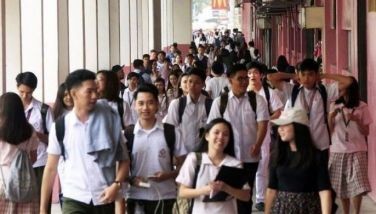Marathon to focus on rebirth of historic Pasig River
February 12, 2004 | 12:00am
For the fourth time in as many years, environmental advocates from both the private and public sectors are set to drum up support and civic awareness for the task of revitalizing the Pasig River by organizing a marathon over a historic route traversing the length of Manila’s principal waterway.
Dubbed as the Pasig River Heritage Marathon (PRHM), the advocacy run held under the auspices of the Clean & Green Foundation, Inc. (C&GFI), takes place on Feb. 29, spanning the length from historic Fort Santiago in Intramuros, Manila through a circuitous city route ending at the cosmopolitan enclave of the Global City in Fort Bonifacio, Taguig.
Unlike other traditional marathons, the PRHM is more than just a competitive race, it is an event that seeks to promote consciousness of the public’s role and responsibility towards the revival and rehabilitation of the Pasig River.
Sportsman Herminio "Hermie" Esguerra, chairman of the PRHM, aptly sums up the objective of the marathon, thus: "to create a high profile awareness that Pasig River is not a giant depository of sewage and that such a message should bring about positive action from all sectors of society."
Lending a historic perspective to the PRHM is the fact that the marathon route has been so designed to allow participants to pass through 11 of the 13 bridges that cross the length of the Pasig River from the Del Pan-Roxas Bridge in Manila to the CP Garcia-C-5 Bridge in Pasig City before the final stretch of the race.
By way of the marathon, organizers of the event hope to "tap the top of every hut, engaging to bear, dare and care for the Pasig River and its banks." Simply put, the whole affair should not just focus on the participants themselves but on its positive impact on the residents, local government units, industries, parishes, schools, youth and media to draw their support and cooperation.
"We should get them involved in the advocacy and do their share in the caring of the Pasig River," Esguerra said.
Organizers of the PRHM have maintained that the success of the whole project would depend on the effective partnership between the government, the NGO’s and the private sector in creating positive awareness of the public’s critical role towards the rehabilitation of the Pasig River.
"The measure of the PRHM’s success would depend on whether our target public, such as our legislators, the clergy, our educators, residents and industries by the riverbanks, the youth, as well as, the media would imbibe our advocacy and individually adopt measures to impart our message to their respective constituencies," he added.
More that the prizes at stake for the PRHM, the biggest winner of the event would ultimately be the future generations of Filipinos who would be able to enjoy the rebirth of the Pasig River and share in the bounty and beauty of what was once Manila’s most precious jewel.
Dubbed as the Pasig River Heritage Marathon (PRHM), the advocacy run held under the auspices of the Clean & Green Foundation, Inc. (C&GFI), takes place on Feb. 29, spanning the length from historic Fort Santiago in Intramuros, Manila through a circuitous city route ending at the cosmopolitan enclave of the Global City in Fort Bonifacio, Taguig.
Unlike other traditional marathons, the PRHM is more than just a competitive race, it is an event that seeks to promote consciousness of the public’s role and responsibility towards the revival and rehabilitation of the Pasig River.
Sportsman Herminio "Hermie" Esguerra, chairman of the PRHM, aptly sums up the objective of the marathon, thus: "to create a high profile awareness that Pasig River is not a giant depository of sewage and that such a message should bring about positive action from all sectors of society."
Lending a historic perspective to the PRHM is the fact that the marathon route has been so designed to allow participants to pass through 11 of the 13 bridges that cross the length of the Pasig River from the Del Pan-Roxas Bridge in Manila to the CP Garcia-C-5 Bridge in Pasig City before the final stretch of the race.
By way of the marathon, organizers of the event hope to "tap the top of every hut, engaging to bear, dare and care for the Pasig River and its banks." Simply put, the whole affair should not just focus on the participants themselves but on its positive impact on the residents, local government units, industries, parishes, schools, youth and media to draw their support and cooperation.
"We should get them involved in the advocacy and do their share in the caring of the Pasig River," Esguerra said.
Organizers of the PRHM have maintained that the success of the whole project would depend on the effective partnership between the government, the NGO’s and the private sector in creating positive awareness of the public’s critical role towards the rehabilitation of the Pasig River.
"The measure of the PRHM’s success would depend on whether our target public, such as our legislators, the clergy, our educators, residents and industries by the riverbanks, the youth, as well as, the media would imbibe our advocacy and individually adopt measures to impart our message to their respective constituencies," he added.
More that the prizes at stake for the PRHM, the biggest winner of the event would ultimately be the future generations of Filipinos who would be able to enjoy the rebirth of the Pasig River and share in the bounty and beauty of what was once Manila’s most precious jewel.
BrandSpace Articles
<
>
- Latest
- Trending
Trending
Latest
Trending
Latest
Recommended





























